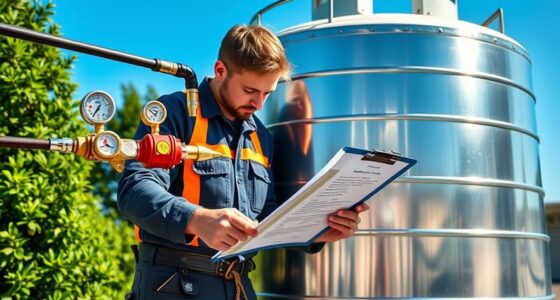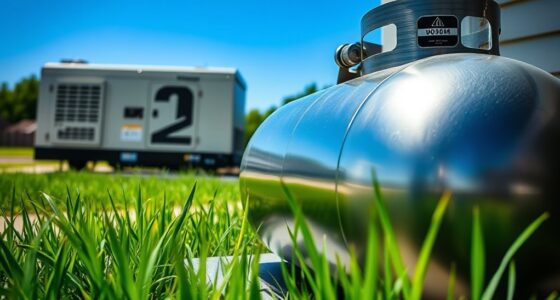Proper gas line sizing is crucial for safety, efficiency, and code compliance. Many myths, like bigger pipes always being better, can lead to costly mistakes. In reality, accurate sizing depends on your system’s flow rate, pressure, and material choices. Oversized or undersized pipes pose risks and inefficiencies. By understanding key factors and standards, you can design a reliable system. Keep exploring to learn essential tips that ensure your gas setup is safe and effective.
Key Takeaways
- Proper gas line sizing depends on flow rate, pressure, and safety standards, not just pipe diameter size.
- Oversized pipes increase costs and complexity without improving performance or safety.
- Accurate calculations using industry standards prevent pressure drops and leaks, ensuring system reliability.
- Material quality and corrosion resistance are crucial for long-term safety, alongside correct sizing.
- Regular maintenance, leak detection, and pressure regulation are essential for system safety and efficiency.
Common Misconceptions About Gas Line Sizing
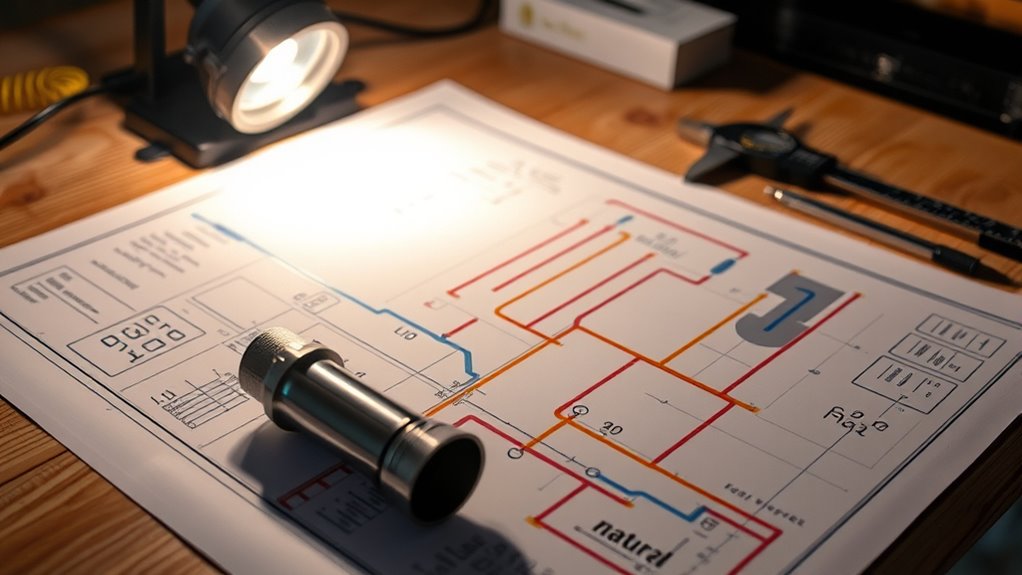
Many people believe that larger gas lines always mean better performance, but this isn’t necessarily true. Gas pressure plays a vital role in how efficiently your system operates, and bigger isn’t always better if the pressure isn’t properly maintained. Oversized pipes can lead to unnecessary costs and complications without improving flow. Additionally, pipe insulation isn’t just for temperature control; it can also help maintain consistent gas pressure by reducing heat loss. Proper sizing considers the right balance between pipe diameter, pressure, and insulation. Proper sizing is essential to ensure optimal performance and safety. Relying solely on larger lines might seem like a quick fix, but it can cause issues like pressure drops or excessive energy use. Understanding these factors helps guarantee your gas system works safely and efficiently, without falling for common misconceptions.
The Importance of Proper Line Sizing for Safety and Efficiency
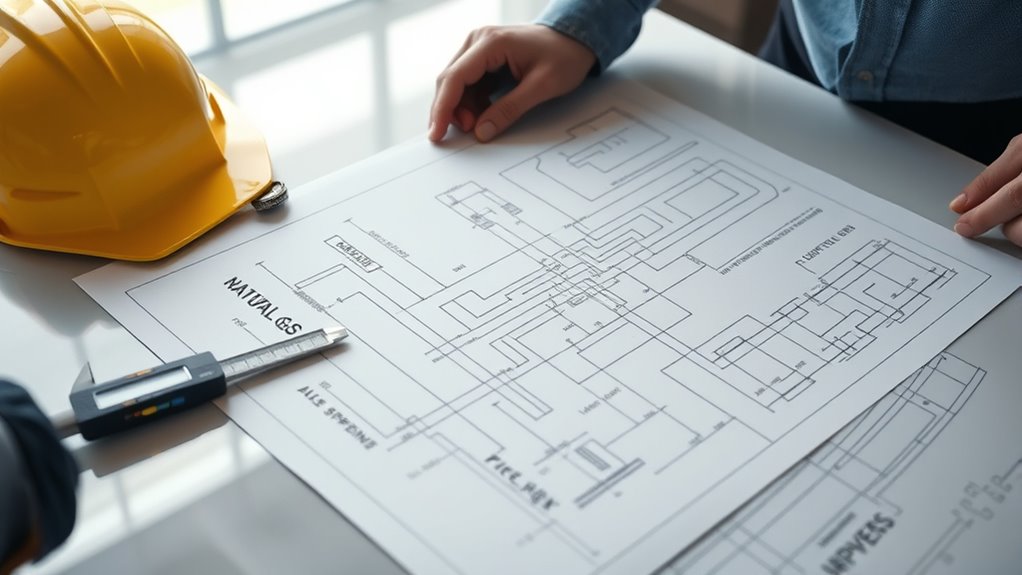
Proper line sizing is essential for guaranteeing your gas system operates safely and efficiently. An appropriately sized line minimizes pressure drops, maintaining consistent flow and reducing the risk of gas leaks. When lines are too narrow, increased pressure can cause leaks or damage connections, compromising safety. Conversely, oversized lines can lead to unnecessary costs and inefficient operation. Gas leak prevention depends on correct sizing, which ensures safe pressure levels and reduces the chance of leaks. Ventilation considerations also play a critical role; proper line sizing helps prevent gas accumulation in enclosed spaces, lowering explosion risks. By prioritizing accurate sizing, you promote a safer environment and optimize system performance, ensuring your natural gas setup functions reliably over the long term. Additionally, understanding the market growth projected at over 40% CAGR in AI tech by 2025 can inform smarter decision-making in system automation and monitoring.
Key Factors That Influence Gas Line Diameter
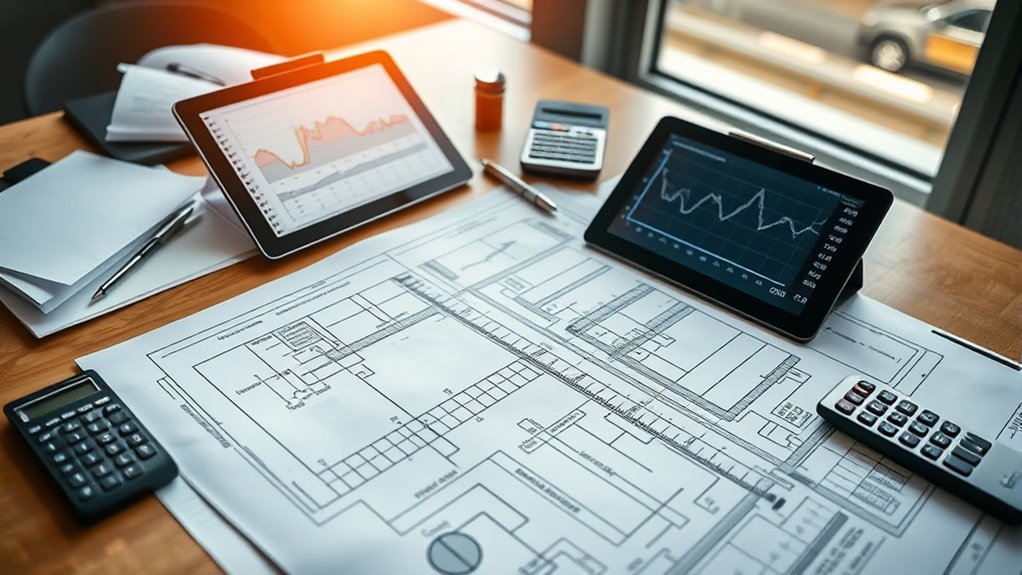
Understanding what influences your gas line diameter is vital for proper sizing. Factors like your gas flow rate, pipe material compatibility, and safety standards all play a role. Considering these points guarantees your system is both safe and efficient. Additionally, implementing AI security measures can help monitor and optimize gas infrastructure safety in modern systems.
Gas Flow Rate Requirements
The gas flow rate is a critical factor in determining the appropriate line diameter because it directly affects pressure drops and system efficiency. Higher flow rates require larger pipe diameters to maintain adequate gas pressure and prevent pressure loss. If your flow rate exceeds the pipe’s capacity, you might experience reduced appliance performance. To optimize flow, consider pipe insulation, which can minimize heat loss and help maintain consistent gas pressure along the line. Proper insulation reduces the need for oversized pipes, saving costs and improving efficiency. Always base your line sizing on your specific flow rate needs, ensuring that your system can deliver the required gas volume without excessive pressure drops. Accurate assessment of flow requirements is essential for a safe, efficient gas distribution system.
Pipe Material Compatibility
Selecting the right pipe material plays an essential role in determining the appropriate gas line diameter because different materials have varying strength, flexibility, and corrosion resistance. You need to consider how well the material resists corrosion, especially if the line runs through humid or chemically aggressive environments. Corrosion can weaken the pipe, leading to leaks or failures that require larger diameters to compensate for reduced capacity. Joint compatibility is another critical factor; incompatible fittings can cause leaks or damage, forcing you to choose a different pipe size or material. By selecting materials with good corrosion resistance and compatible joints, you guarantee the integrity of your gas line, maintain ideal flow, and avoid unnecessary enlargements or replacements that could complicate your installation. Well-chosen material options ensure durability and optimal performance in various environments.
Safety and Code Standards
Safety and code standards play a vital role in determining the appropriate gas line diameter because they set mandatory guidelines that must be followed to guarantee safe operation. These standards ensure proper corrosion prevention measures are in place, reducing the risk of leaks and failures over time. They also specify requirements for emergency shutoff valves, which are crucial for quickly stopping gas flow during emergencies. Adhering to these codes helps prevent hazards such as explosions or carbon monoxide buildup. By following local building codes and industry regulations, you ensure your gas system is safe, reliable, and compliant. Proper line sizing, combined with these safety protocols, minimizes potential risks and guarantees the integrity of your natural gas installation. Regularly consulting industry standards ensures ongoing compliance and safety.
How to Calculate the Right Gas Line Size

To ascertain the right gas line size, you need to start by calculating the required gas flow rate for your system. Then, you’ll apply industry standards and codes to guarantee your calculations meet safety and efficiency guidelines. This process helps you select a line diameter that safely delivers the necessary gas volume without unnecessary oversizing. Additionally, understanding the bedroom environment can influence your planning, as factors like layout and appliances impact flow requirements.
Determining Gas Flow Rate
Understanding the gas flow rate is essential for accurately sizing your gas line. To determine it effectively, consider these key points:
- Measure your total appliance demand to understand the maximum cubic feet per hour needed.
- Know your gas pressure, as lower pressure can reduce flow capacity, impacting line size.
- Use industry flow charts to match flow rates with pipe diameters.
- Remember, oversizing can increase installation costs without benefits, while undersizing risks insufficient supply.
Calculating the correct flow rate helps balance safety, efficiency, and costs. Properly evaluating flow ensures your gas pressure remains stable and reduces unnecessary installation expenses. By focusing on these factors, you’ll choose a line size that accommodates your needs without overspending or risking inadequate supply.
Applying Industry Standards
Applying industry standards guarantees your gas line is correctly sized to meet demand without overspending. To do this, follow established codes and guidelines, ensuring safe operation and compliance. Start by calculating the required flow rate and pressure drop, then select pipe diameters accordingly. Proper pressure testing is essential to verify the integrity of the installation and detect potential gas leaks before use. Using industry standards helps prevent undersized lines that can cause pressure drops or gas leaks, and oversized lines that increase costs. Always reference relevant codes like the National Fuel Gas Code or local regulations. Additionally, understanding the importance of proper sizing ensures your system operates efficiently and safely. By applying these standards diligently, you ensure your gas line is safe, efficient, and compliant, providing peace of mind and reliable performance.
Myths vs. Facts: What Really Matters in Gas Line Planning

Many common beliefs about gas line planning can lead you astray, but separating myths from facts is essential for safety and efficiency. Here are key truths you need to know:
- Proper sizing prevents gas leaks caused by pressure drops.
- Using high-quality materials enhances corrosion prevention.
- Overestimating pipe size doesn’t improve safety; it wastes resources.
- Regular inspections are critical to detect early signs of corrosion and leaks.
Ignoring these facts can increase risks, compromise system integrity, and lead to costly repairs. Understanding what actually matters—like ensuring correct sizing, choosing corrosion-resistant materials, and prioritizing safety protocols—is indispensable for a reliable gas distribution system. Don’t fall for misconceptions; focus on facts to keep your gas line safe and efficient.
Practical Tips for Designing an Effective Gas Distribution System

Designing an effective gas distribution system starts with careful planning to guarantee safety, efficiency, and long-term reliability. Begin by selecting appropriate pipe sizes to minimize pressure drops and ensure consistent flow. Incorporate pressure regulation at key points to maintain safe operating pressures and prevent system damage. Proper pressure regulation also helps optimize gas usage and safety. Implement leak detection methods early in the design to identify potential issues before installation, reducing risks and costly repairs later. Regularly check for leaks and maintain pressure regulators to ensure ongoing safety. Use materials resistant to corrosion and verify that connections are secure. Additionally, understanding spiritual energy transfer and maintaining awareness of energy shifts can enhance overall system resilience. Remember, a well-designed system prioritizes leak detection and pressure regulation, which are critical for safe, efficient, and durable gas distribution.
Frequently Asked Questions
How Does Local Building Code Affect Gas Line Sizing Decisions?
Local building code directly influences your gas line sizing decisions by ensuring building code compliance and safety regulations are met. You must follow specific standards for pipe diameters, pressure, and installation methods to prevent hazards. Ignoring these codes can lead to safety risks, legal issues, and costly rework. Always check your area’s regulations first, and prioritize safety regulations to guarantee a secure and compliant gas system.
What Role Does Future Expansion Planning Play in Current Line Sizing?
Future expansion planning influences your current line sizing by guaranteeing your pipeline has enough capacity for growth. You should consider potential increases in demand and incorporate safety margins to prevent pressure drops or blockages. This proactive approach helps avoid costly upgrades later, maintains safety, and guarantees consistent service. By sizing your gas line with future needs in mind, you ensure reliable operation and flexibility for expanding your system efficiently.
Are There Environmental Impacts Linked to Improper Gas Line Sizing?
Yes, improper gas line sizing can lead to environmental consequences, including pollution concerns. When lines are too small, pressure drops may cause leaks or incomplete combustion, releasing methane and other pollutants into the air. Conversely, oversized lines can waste resources and increase energy consumption. Ensuring proper sizing minimizes these risks, protecting the environment and reducing pollution concerns. Accurate planning helps prevent these issues before they impact your surroundings.
How Do Fluctuating Gas Demands Influence Line Diameter Choices?
Fluctuating gas demands are like a roller coaster ride, affecting your line diameter choices. You need to account for flow variability to prevent pressure drops or surges, which can compromise safety and efficiency. Proper pressure management becomes vital, so selecting a larger diameter than initially needed can accommodate demand peaks. This approach ensures your system remains stable, responsive, and capable of handling demand swings without risking damage or service interruptions.
What Are the Costs Associated With Incorrect Gas Line Sizing?
If you size your gas line incorrectly, you face higher installation costs due to rework or upgrades, and safety risks increase from potential leaks or pressure issues. Inaccurate sizing can lead to inefficient gas flow, causing equipment damage or failure. These mistakes not only strain your budget but also jeopardize safety, emphasizing the importance of precise line sizing to avoid costly repairs and safety hazards.
Conclusion
Remember, choosing the right gas line size isn’t just about numbers—it’s about safety, efficiency, and peace of mind. Don’t let myths cloud your judgment; instead, focus on the facts and key factors that truly matter. Think of your gas system as the backbone of your home’s comfort—strong, reliable, and built on informed decisions. When you prioritize proper planning, you’re not just installing pipes; you’re securing your peace of mind for years to come.



